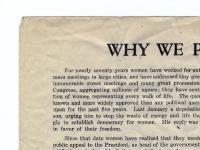The Pennsylvania branches of The National American Woman Suffrage Association (NAWSA) and The National Woman’s Party (NWP) employed a variety of tactics to advocate for their cause. Holding meetings, distributing literature, and writing newspaper and magazine articles were the primary activities of the Pennsylvania branch of NAWSA. It affirmed in 1913 that the organization would pursue “educational methods in keeping with the dignity of the movement and the character of the women engaged in it.” To encourage men in Pennsylvania to support the 1915 referendum, NAWSA members traveled to every county in the state with the “Justice Bell,” a replica of the Liberty Bell.
When NWP founder Alice Paul came to Philadelphia in 1913, she conducted controversial “open air meetings” in places such as City Hall plaza and a busy intersection in the neighborhood of Kensington. Once attention turned to the White House and the Congress, Pennsylvania women participated in NWP’s increasingly aggressive strategies. In 1916, NWP organized the Silent Sentinels, the first group to ever picket in front of the White House. Later, the Sentiels participated in the “Watchfire” protests during which Woodrow Wilson’s speeches were burned and his body was hanged in effigy. They hoped to pressure Wilson to follow through on promises to promote a suffrage bill in Congress and to point out the hypocrisy of engaging in a war “for democracy” abroad while women in the United States were denied the franchise. Numerous participants in these demonstrations were arrested, charged with “obstructing traffic,” and imprisoned at Occoquan Workhouse. Many prisoners, including Dora Lewis, reported being beaten, verbally harassed, and compelled to endure an airless, rat-infested facility. Alice Paul, who was kept in solitary confinement, launched a hunger strike to protest the deplorable conditions. Paul was force-fed by prison authorities and transferred to a psychiatric ward. In spite of the arrests, protests continued for 18 months. Publicity about the arrests and subsequent abuse in jail engendered outrage and led to increased support for the cause. All charges against the women were eventually dropped.


